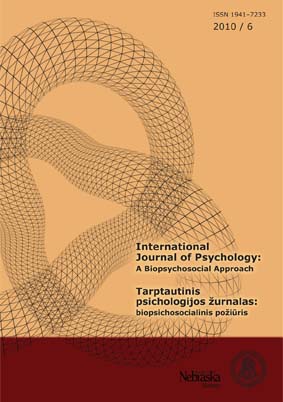Standartizuoto akademinio progreso matavimo testo rezultatų numatymas taikant mokymo programa pagrįstą skaitymo gebėjimų vertinimą Nebraskoje
Using Reading Curriculum-Based Measurements as Predictors for the Measure Academic Progress (Map) Standardized Test in Nebraska
Author(s): Tammi Ohmstede Beckman, Karen MerinoSubject(s): Psychology
Published by: Vytauto Didžiojo Universitetas
Keywords: curriculum-based measurement; standardized tests; measures of academic progress; mokymo programa pagrįsti rodikliai; standartizuoti testai; akademinio progreso matas
Summary/Abstract: Background. Research studies have examined CBMs as predictors of standardized test performance; however, no studies have examined the possible predictive relationship between CBMs and the MAP test with a diverse population in the state of Nebraska. Purpose. This study measures the efficacy of using curriculum-based measurements, oral reading fluency and maze, as predictors of performance on he Measures of Academic Progress (MAP) in the state of Nebraska. Methods and Results. Archival data were collected from a public elementary school in Nebraska, which enrolls diverse students from many cultural backgrounds. The participants of this study were 376 elementary students in 2nd through 5th grade. The participants took the CBM oral reading fluency, maze, and MAP reading assessments in the Spring and Fall Semesters of the year 2009. The findings of this study indicated that the oral reading fluency and the combination of oral reading fluency and maze scores significantly predicted MAP reading scores (p < .05) in both semesters. Conclusions. The evidence obtained in the present study suggests the idea of using oral reading fluency to monitor students’ progress and to use it to target students who are at-risk of failing high-stakes reading tests. Problema. Mokymo programa pagrįsto gebėjimų vertinimo ir standartizuotų testų atlikimo sąsajos nagrinėjamos gana plačiai, tačiau šio vertinimo prognozinė vertė, numatant standartinio akademinio progreso matavimo testo rezultatus, apimant didelę populiacijos įvairovę Nebraskos valstijoje, nėra tyrinėta. Tyrimo tikslas. Įvertinti mokymo programa pagrįstų skaitymo gebėjimų rodiklių (garsaus skaitymo sklandumo ir labirinto užduočių) efektyvumą, numatant akademinio progreso testo rodiklius Nebraskos valstijoje. Metodika. Tyrimui buvo panaudoti archyviniai duomenys iš valstybinių pradinių Nebraskos mokyklų, kuriose mokosi įvairaus kultūrinio pagrindo mokiniai. Iš viso tyrime dalyvavo 379 pradinės mokyklos mokiniai, besimokantys 2–5 klasėse. Mokymo programa pagrįsti gebėjimų rodikliai, garsaus skaitymo sklandumas ir labirintas bei akademinis progresas buvo įvertinti 2009 metų pavasario ir rudens semestruose. Rezultatai. Tyrimo rezultatai atskleidė, kad garsaus skaitymo sklandumas ir skaitymo bei labirinto užduoties įverčių sąveika reikšmingai prognozavo akademinio progreso rodiklius (p<0,05) per abu semestrus. Išvada. Gauti rezultatai atskleidžia garsaus skaitymo sklandumo testo vertę mokinių pasiekimų progreso stebėsenai bei galimybes pritaikyti šį matą mokiniams, kuriems gali kilti sunkumų atliekant kitus skaitymo testus, atpažinti.
Journal: Tarptautinis psichologijos žurnalas: biopsichosocialinis požiūris
- Issue Year: 2010
- Issue No: 6
- Page Range: 85-98
- Page Count: 14
- Language: English

